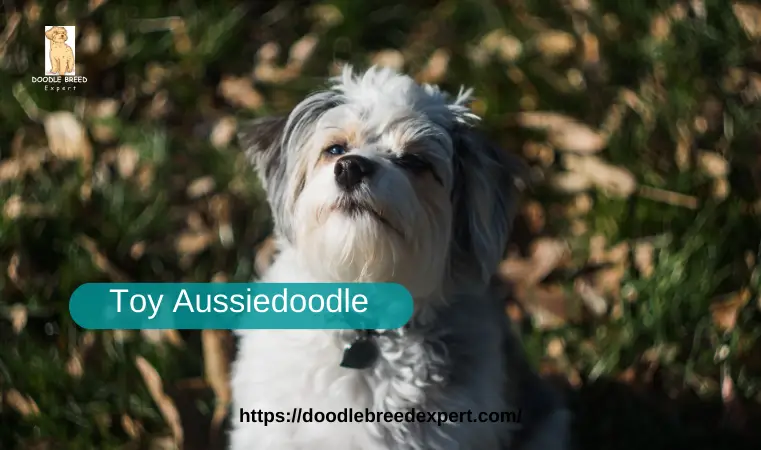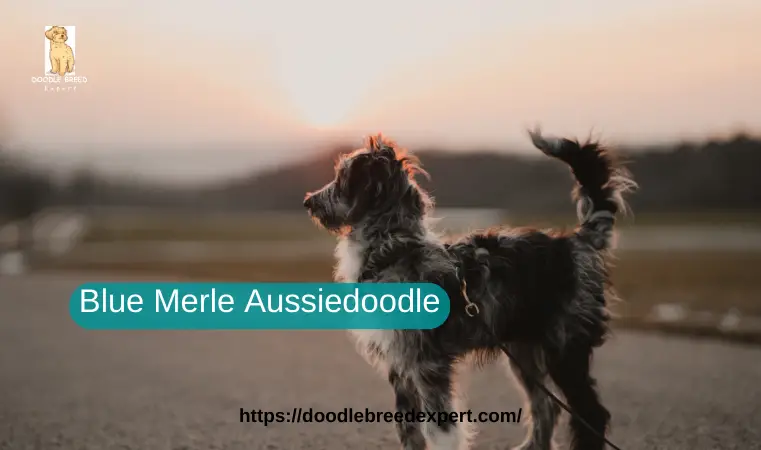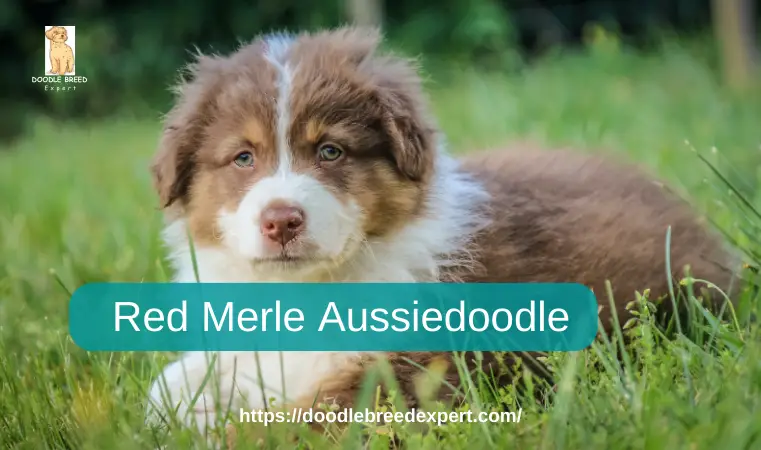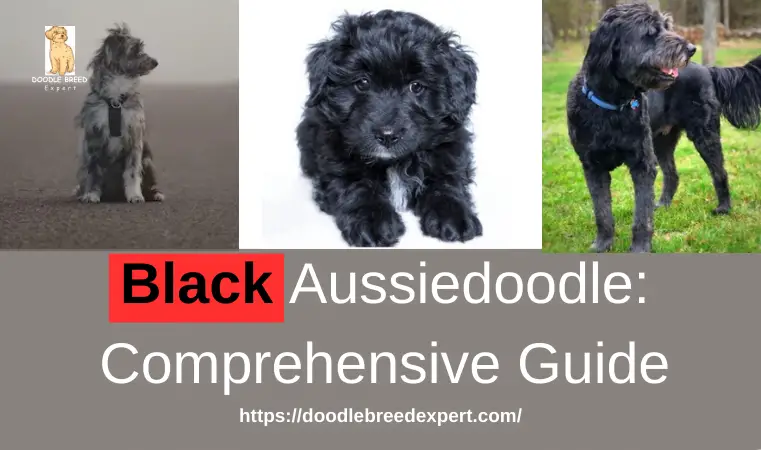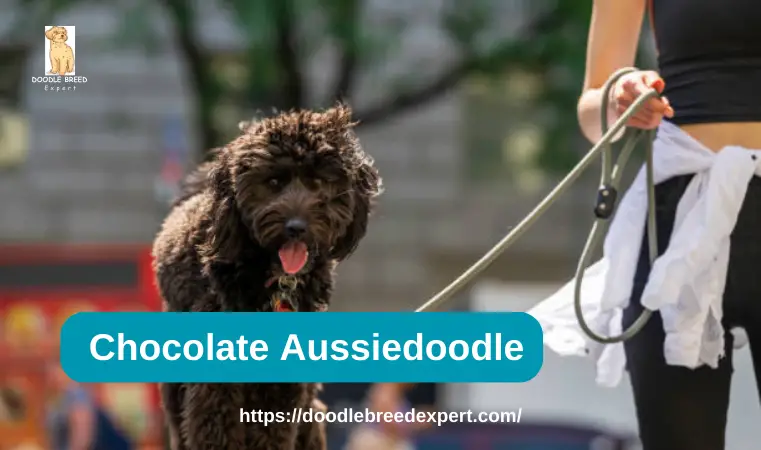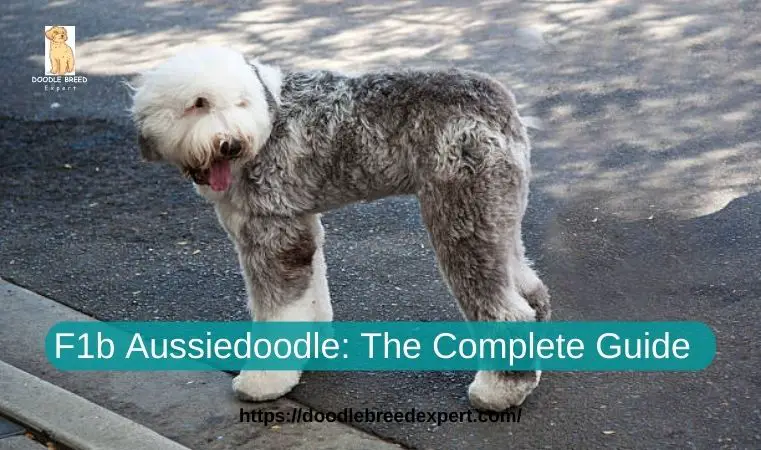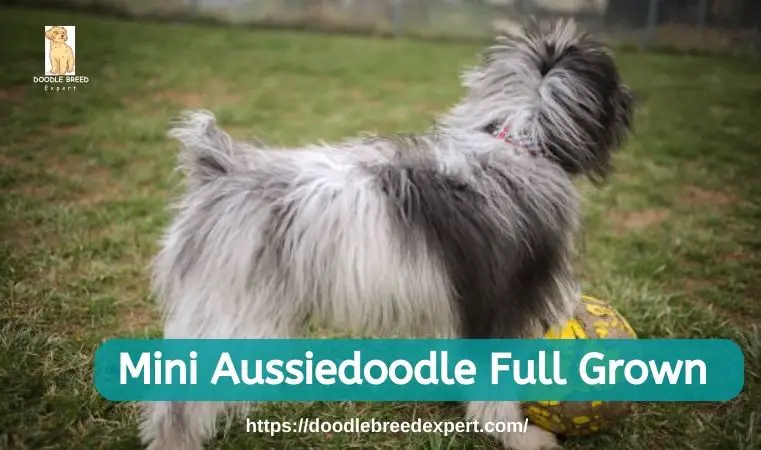The Toy Aussiedoodle is what is produced when an Australian Shepherd is crossed with the Toy or Miniature Poodle. The intentional cross combines the Australian Shepherd’s herding spirit and loyalty with the intelligence and low-shedding, curly coat of the Poodle.
The cross may be referred to as an “Aussiepoodle” or “Aussiepoo” and is found in three different sizes (Toy, Miniature, and Standard) depending on the Poodle parent. Contrary to the name, the Australian Shepherd was developed on the west coast of the United States and not in Australia.
The Toy Aussiedoodle is just the smallest version (sired by the Toy Poodle) of the Aussiedoodle cross. It is not recognized as an AKC breed, but it is recognized by registries of designer-dog breeds (for instance, the IDCR has the Toy Aussiedoodle as the name associated with the cross).
The puppies are loved as loving, energetic companions that tend to thrive as family pets and even as therapy animals because of their trainability and people-focused nature.
Popularity Trends
Aussiedoodles (toy) have proliferated in the last twenty years as one of the “doodle” trend’s cornerstones. By the 2010s, Goldendoodle and Labradoodle crosses paved the way for others, and Aussiedoodles followed soon after.
Aussiedoodle breed profiles observe that Aussiedoodles “have gained traction” among puppy fans on account of the combination of intelligence, flexibility, and hypoallergenic coat. Moreover, popular pet publications tend to include Aussiedoodles on the list of most-loved doodle hybrids.
For instance, Petmd features the Aussiedoodle on its “most popular doodles” list, citing the “goofy and loving personalities” of these delightful hybrids. This is part of an all-around trend: according to a survey conducted in 2023, more than 60% of animal shelters report an increase in the number of doodle and intentionally mixed-breed admissions, which indicates the high demand (and, unfortunately, sometimes the high surrender rate) for these crosses.
Briefly, the Toy Aussiedoodle is one of the cornerstones of an exploding designer-dog market, and there is no decline on the horizon as long as people seek out intelligent, active, yet snuggly companions.
Origin and Breeding History
The Aussiedoodle emerged in the late 1990s and early 2000s in North America as an extension of the pioneering 1980s Labradoodle. Early breeders specifically mated Australian Shepherds and Poodles to combine desirable characteristics.
Although both parent breeds trace deep into history (the Australian Shepherd became popular during the Gold Rush of the American West, and the Poodle has Eurasian origins), the Aussiedoodle itself is an emergent breed. Its exact origins are not officially on record, but similar to many poodle-cross hybrids, it became popular in the 1990s as people looked for smart, versatile pets.
The Australian Shepherd brings energy, herding ability, and loyalty, and the Poodle provides hypoallergenic coat characteristics and trainability. The earliest breeders aimed to merge these positives. Today’s Aussiedoodles are also sometimes the product of multi-generational crosses (breeding an Aussiedoodle to the Poodle, for example) to stabilize the characteristics.
A notable point is that since the Aussiedoodle is not an AKC-recognized breed, good breeding is done on an entirely voluntary basis and depends on voluntary health testing and breed clubs (designer registries ACHC and IDCR list Aust-Poos as names such as the Toy Aussiedoodle or the Aussie-Poo). The history of the breed overall is one of intentional crossbreeding for an active, allergy-conscious family pet.
Appearance and Physical Characteristics
Toy Aussiedoodles take on many different appearances from their parents.
Coat Type:
They may sport straight, curly, or wavy coats. Frequently, the coat is slightly curly or wavy as a result of the Poodle influence, and is therefore relatively low-shed and described as hypoallergenic. The Coat texture, though, varies within one litter: there are puppies with tightly curled coats and others with the smooth fur of an Aussie.
Coat Patterns and Colors:
Coat colors range the whole gamut, inherited from the parents. The common hues are black, white, cream, gray, brown (chocolate), red, and combinations. The Australian Shepherd genes sometimes contribute the merle patterns (red or blue merle) that give rise to the mottled or speckled appearance, and many Aussiedoodles also exhibit two-tone or parti-color markings (white patches and another color) and phantom (tan markings on an otherwise darker coat). For instance, the merle coat can be bluish-gray with black and white markings, sometimes accompanied by striking blue or heterochromatic eyes.
Eye Color:
Aussiedoodles can be brown, amber, blue, or green-eyed, and one blue and one brown eye (heterochromia) is not unusual because of the Aussie influence.
Size and Build:
Being a “Toy” variety, these Aussiedoodles are the smallest of the bunch. Adult Toy Aussiedoodles are usually 10–14 inches at the shoulder and weigh approximately 8–20 pounds, many averaging 10–15 pounds. (Mini Aussiedoodles tend to weigh 15–35 pounds, and Standard Aussiedoodles are 40–70 pounds.) Even at small stature, though, Toy Aussiedoodles are well-proportioned and athletic, neither dainty as in a toy breed nor massive as in a mastiff.
They tend to sport a middle-of-the-road muzzle (longer than an Aussie’s but shorter than a Poodle’s), floppy ears, and an intelligent expression. On the whole, physical characteristics can differ widely, but you can expect to find (for example) a small, sturdy dog with soft, curly hair, expressive eyes (often blue or multi-colored), and an intelligent, friendly face.
Temperament and Behavior
Toy Aussiedoodles are intelligent, energetic, and loving. The two parent breeds are among the cleverest of canines, and the Aussiedoodle inherits these traits, quickly picking up on things.
They are typically playful, eager-to-please dogs that bond strongly with their owners. With good socialization, Aussiedoodles are friendly to children and other animals – many owners comment that they are loving and doting companions for children.
According to one breeder, “they are great with families and small kids too”. Their social nature tends to render them bad guard animals in the sense that there is an attack response, but as alert watchdogs, they do the trick: you’ll know when someone strange or unknown is approaching the dwelling once the Aussiedoodle starts to bark.
The key characteristics are:
Affectionate and loyal:
Aussiedoodles adore attention and are fond of cuddling. They frequently desire to participate in family activities and are very dedicated to “their people”.
Friendly and Active:
These breeds are full of energy. Daily playtime or agility training is enough to appease them. Boredom can lead them to express energy through misbehavior (chewing, digging), so plenty of exercise is important.
Smart and Trainable:
Aussiedoodles are very fast at learning commands. They are kept occupied by using mental games and positive training techniques. Their intelligence, though, makes them stubborn or obstinate at times, so reward-based, regular training is best.
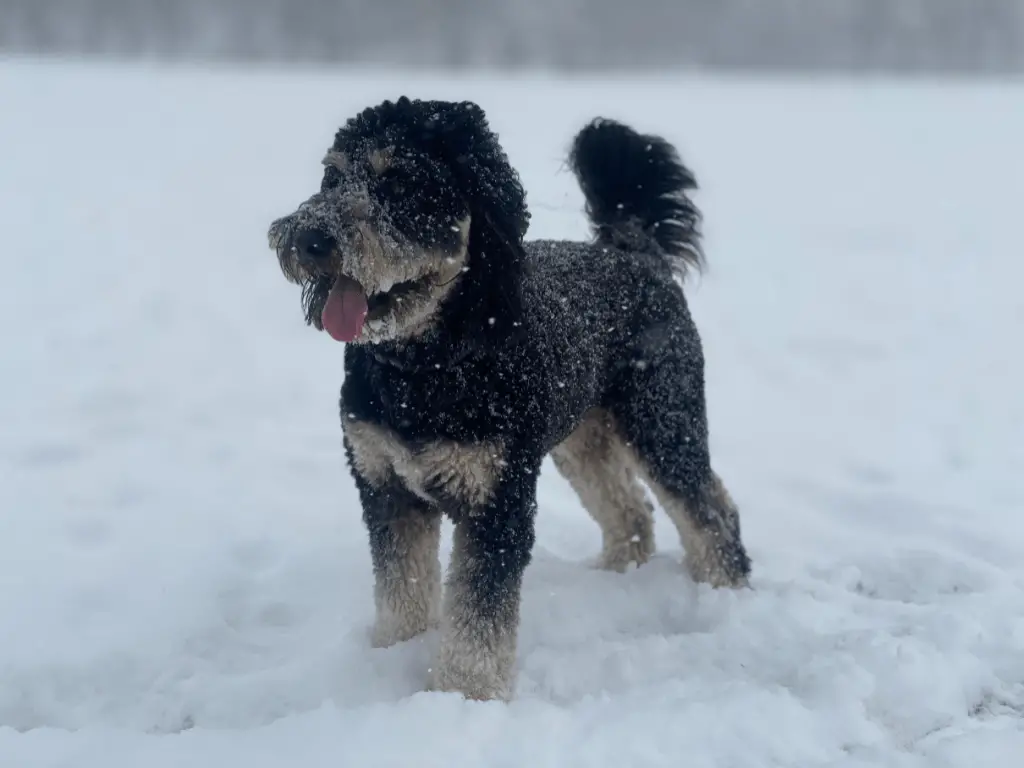
Herding Instincts:
As the parent is itself a herding breed, some Aussiedoodles tend to herd things that move – for instance, nipping at the heels of running kids or other pets. It is best to train them early to “leave it” or redirect them using games.
Alert and Vocal:
They are not normally yappy in nature, but as with many middle-sized breeds, they do alert-bark as the situation demands. North Lake Aussies discusses how Aussiedoodles tend to be good “watchdogs” and bark to alert to strangers. Excessive barking is controlled by early and calm training.
Overall, the Toy Aussiedoodle is an extroverted, people-oriented companion dog. They thrive best in households where there is someone who can play with them regularly and keep them mentally stimulated. They are not typically aggressive; the largest of their “issues” stems from excess energy or separation anxiety if left to be on their own for long hours. Through patient training and extensive exercise, Aussiedoodles turn into loving, lively family companions.
Health and Common Genetic Issues
Aussiedoodles gain the benefit of mixed-breed vigor (genetic diversity), but are still prone to inherited illnesses from either parent line. The key to reducing risks is good breeding and health testing. Potential health issues are:
Hip and Elbow Dysplasia:
Aussies and Poodles are susceptible to joint dysplasia. An Aussiedoodle can inherit improperly developed elbow or hip joints. This may cause arthritis or lameness later in life. Good breeders check the animals through OFA or Pennhip and do not breed the afflicted animals. Keeping weight in check and engaging in joint-conscious workouts is beneficial, but extreme symptoms may need to be treated medically.
Eye Issues:
The Aussie parent may pass along eye disorders such as progressive retinal atrophy (PRA), cataracts, and Collie Eye Anomaly (CEA). Therefore, Aussiedoodles are at risk of vision impairment. Routine eye exams by the veterinarian are recommended. Cataracts, particularly early-onset, are reported; with timely detection, certain diseases can be treated or controlled. The Aussiedoodle Embark DNA profile notably points to PRA and inherited cataracts as risk areas.
Endocrine and Thyroid Issues:
Hypothyroidism (commonly autoimmune) is found in Australian Shepherds. Signs are weight gain, lethargy, or skin problems; it is usually manageable with medication. Poodles are at risk for Addison’s disease (adrenal insufficiency) and Cushing’s (less so in Aussies). These conditions impact hormonal balances and are managed with veterinary care. In an Aussiedoodle, it is prudent to test the parents for thyroid function and to monitor the health of the puppy (blood tests, hormone testing if the puppy shows symptoms).
Skin Coat Problems:
Poodles are prone to sebaceous adenitis, an irritated skin condition that results in dry, flaky skin and hair loss. Aussiedoodles can inherit the propensity for it, and it may result in medicated shampoos or special grooming. They can develop food and environmental sensitivities (itchy ears or skin) as many breeds do. A good diet and ear cleaning regularly (it’s easy for Aussiedoodle ears to become damp) prevent irritation.
Neurological Disorders:
Epilepsy (seizures) gene variants are carried by both breeds. While not very frequent, antiseizure medication may be indicated if the dog is affected. Degenerative myelopathy (Lou Gehrig’s disease) is the risk found in most shepherd breeds and has also been found in Aussiedoodles (through DNA markers).
Bloat (Gastric Torsion):
Bloat affects deep-chested breeds and occurs when the stomach twists after being overly full. Standard Aussiedoodles with Standard Poodle genes are most prone to bloat, but smaller Aussiedoodles should be fed smaller meals and not exercised hard directly after meals.
MDR1:
The MDR1 gene mutation (frequent in the herding group) sensitizes the dogs to specific drugs (such as Ivermectin). It occurs in some Aussiedoodles. Breeders can check for MDR1 to avoid hazardous medication responses.
Overall, all dogs can inherit genetic problems, and an Aussiedoodle can inherit any condition that the parent breeds are at risk of. Many Aussiedoodle breeders suggest DNA health testing that screens for scores of conditions.
The Embark test certainly identifies several illnesses for the mix (e.g. MDR1, PRA, von Willebrand’s, NCL, etc.). Potential owners can ask breeders for parent health clearances (hips/elbows, eyes, cardiac, patella, thyroid, etc.) and consider using the puppy DNA test. With proper breeding, many Aussiedoodles are very healthy and live well.
Grooming and Care Requirements
The coats of toy Aussiedoodles demand regular grooming. Although most exhibit low shedding because of the Poodle coat, the hair can mat and tangle very quickly if not maintained. The main care steps are:
Brushing:
Brush your Aussiedoodle 2–3 times weekly (daily is best on curly coats) to avoid matting. The Brush using a slicker or comb that reaches the skin. Brush thoroughly behind the ears and on the legs, where tangles tend to lurk.
Bathing and Grooming:
Bathe as needed (around once a month) using a mild dog shampoo to maintain the cleanliness of the coat. A professional groomer is visited by most owners every 8–12 weeks for an all-over clip. The eyes and pads are trimmed by the professional groomer, nail clipping, and the sanitary clip. A haircut (puppy cut) is needed by many Aussiedoodles if the curls become very long.
Ear Care:
Because Aussiedoodles have floppy ears, they can trap dirt and moisture. Check and clean the ears weekly with a vet-approved solution to prevent infections. Trimming hair around the ear canal helps keep them ventilated.
Teeth and Nails:
Clean the dog’s teeth several times per week to avoid plaque. Clip the nails every few weeks (long nails are painful). A clip or file will do, as active dogs wear the nails down to an extent on walks.
Exercise:
Australian Shepherds are classified as herding animals, and as such, Aussiedoodles require plenty of exercise. Be prepared to provide at least 1 hour of intense daily activity. This may consist of walking, running, throwing balls, or agility. Toy Aussiedoodles enthusiastically participate in walks, hiking, and playtime. A lack of exercise tends to lead to behavioral problems. Mental stimulation is just as crucial: utilize treat puzzles, obedience, and play.
Diet:
Feed them a high-quality food suited to their life stage. Due to the high energy level of Toy Aussiedoodles, they tend to thrive on a diet that is moderately fat and protein-rich. Monitor the portion to avoid obesity (the smaller dogs can quickly gain weight). Prevent gulping by using slow-feeder bowls as necessary.
Training and Socialization:
Start training and socializing at an early stage. Practice basic obedience and promote quiet indoor manners. Aussiedoodles are intelligent and love to have something to do, so dog sports (rally, agility) can be ideal. Repetitive, reward-based training will set good manners (crating, no jumping, quiet greetings) in place. Socialization at an early stage allows them to develop into confident, well-adjusted adults.
By grooming and staying active, you’ll be able to keep your Toy Aussiedoodle healthy and content. Their grooming requirements are higher than for a short-haired breed but usually lower than for an entire Poodle. You’ll receive the reward of an attractive, low-shedding friend in return.
Size and Growth Expectations
The smallest of the Aussiedoodle varieties, the Toy is the most compact. Individual animals, of course, differ, but typical size ranges are:
Height:
Toy Aussiedoodles stand approximately 10–14 inches at the shoulder at maturity. Some very small individuals are closer to 10 inches, and others are 12–14 inches.
Weight:
Adult Toy Aussiedoodles normally weigh somewhere between 8 and 20 pounds. Oftentimes, they turn out to be 10–15 pounds. To put that into perspective, the Miniature is up to ~30–35 lbs, and the Standard Aussiedoodle is 40–70 lbs.
Growth Rate:
These puppies grow quite rapidly to reach full adult height. By approximately 10–12 months, the Toy Aussiedoodle is typically full-grown. Males tend to be slightly bigger than females on average. Keep in mind that littermates can still differ by a couple of inches or pounds, depending on genetics.
Because Toy Aussiedoodles are born from crossing a Toy Poodle with a smaller Australian Shepherd (usually a “Mini Aussie” which is itself approximately 20–30 lbs), you are not going to get an actual “toy” Australian Shepherd parent.
So, sometimes breeders label an extremely small Mini Aussie as “Toy,” but the sire is 20–25 lbs and the cross is a Toy-medium, not super-tiny. Always ask to meet the parents: if sire and dam are both below ~20 lbs, you are likely to obtain an extra-small puppy. Otherwise, you are looking at about 10–15 lbs with an extremely small build.

Finding a Reputable Breeder
Since Aussiedoodles are designer breeds, shopping intelligently is essential. Guidelines for the selection of an ethical Toy Aussiedoodle breeder are listed below:
Health Testing:
A good breeder is going to have extensive health testing on both parents. This ranges from hip and elbow testing (OFA/Pennhip), eye exams by an ophthalmologist (OFA CERF), cardiac assessments, and patella (kneecap) testing. In addition to these, they should also screen for known inherited problems such as MDR1 sensitivity, PRA/CEA DNA, thyroid function, and others. PetMD says to seek an “ethical breeder who screens the health of his or her dogs.” Be cautious of one who has no health records or says there are no health issues without substantiation.
Meet the Parents:
You ought to meet (personally or through live video) the puppy’s parents. A reputable breeder makes it possible to witness the temperaments of the adults and where they live. The dam (mother) ought to be present along with the litter. Getting to know the parents assists in verifying the anticipated size and temperament of the future pup.
Breeder Reputation:
Find breeders who specialize in Aussiedoodle (and particularly Toy Aussiedoodle) breeding. Read reviews, ask for references, and ensure that they have a healthy program (e.g. one where healthy litters are consistently produced). They should be familiar with Australian Shepherd and Poodle lines. Registries such as the International Designer Canine Registry (IDCR) or American Canine Hybrid Club (ACHC) list registered Aussiedoodle litters; using one of these registries to find a breeder provides credibility.
Environment:
A good breeder raises the puppies in a safe, clean, and loving home environment (also known as puppy culture or early neurosensory stimulation). Puppies ought to be socialized to people and perhaps other well-behaved pets. Be wary of breeders who house the dogs in kennels or breeders who continually have several breeds/litters on offer (an indicator of a mill). A breeder ought to ask you many questions as well to find you the best home.
Breeder Contract:
A written contract or warranty is what you should expect. This may include health (e.g., guarantee of disease-free genes for a amount of time, spay/neuter conditions) and a provision that the puppy is to be returned to a breeder in case you cannot keep it. Ethical breeders will also stay in contact, providing information and asking for progress reports on the pup.
Be wary of Red Flags:
Be wary of any breeder who insists on all payment upfront, sight-unseen, or who does not permit you to come to the property. Question anyone who advertises as having the “Toy Australian Shepherd” because that is not an official separate breed (minis are sometimes labelled as “toy”). Ditto on the very low prices on what is a “rare” coat (merle Aussiedoodle under $1000, etc.). Check credentials and trust your gut.
By doing homework and selecting a breeder who values health and temperament, you significantly decrease the possibility of behavioral or health problems in the future. Don’t forget that puppy mills and scams are an all-too-real concern within the doodle community, so taking the diligence to do your homework is key.
Cost and Pricing Factors
Toy Aussiedoodle puppies tend to be quite pricey. The initial price ranges between roughly $1,200 and $3,500 or possibly higher, depending on several components. Significant price drivers are:
Coat Color/Pattern:
Merles or particolors, and rare coloration in general, tend to cost extra. One breeder prices the following: bi-color puppies at $2,500-$3,000, tri-color at $2,500-$3,300, and merle as much as $3,000-$4,500. This is an example of market demand for something different.
Reputation of the breeder and lines:
Champion or sought-after lines (particularly health-checked or show-quality lines) can increase the price. Good customer reviews of established breeders may command higher prices due to assured health testing and better early socialization.
Location and Demand:
The prices are subject to regional differences. Where there are not many Aussiedoodle breeders but the demand is high, the prices are higher. On the other hand, adopted puppies or puppies from shelters (uncommon for this designer breed) can range from an adoption cost of ~$150–$600. Finding an Aussiedoodle Toy in rescue is extremely unlikely; the majority are sold by breeders.
Breeder Costs:
Good breeders spend hundreds of dollars on health testing (hip evaluations, OFA eyes, DNA profiles, etc.) on the parents. These charges are included in the price of the puppy. A less expensive puppy may indicate shortcuts were taken (no testing, neglected care), which can translate into higher medical expenses in the future.
In addition to the cost of the purchase, new Aussiedoodle owners need to plan on the upfront expenses: crate, bed, collar, leash, toys, puppy-proofing materials, and the initial vaccinations and vet checkup (usually $300–$1,000). Some breeders include some of these services (vaccinations, microchipping, deworming) in the price. First-year expenses also cover spay/neuter surgery, if it has not already been performed, which is several hundred dollars.
Ongoing expenses are large as well. You can expect at least two trips to the vet yearly (annual check-up, shots, and regular tests). You’ll need to budget for preventatives for heartworms/fleas, good grub (to supply them with energy), and professional grooming every 2–3 months (grooming can cost $50+ per session). If you opt for pet insurance, that’s an extra ~$300–$600 yearly. With all these included, yearly expenses (pet food, vet, grooming, toys) can run well over $1,000.
Plan for long-term expenses as well:
obedience school or sport club fees for the dog, boarding or pet-sitting on an as-needed basis, and the possibility of medical emergencies. Insurance coverage is sometimes recommended for Aussiedoodles because of the possibility of inherited disorders. In short, the cost of ownership of a Toy Aussiedoodle is much greater than the cost at the time of purchase.
FAQs
Do Toy Aussiedoodles bark a lot?
They are vocal but are not extreme barkers at heart. The majority of Aussiedoodles do bark to notify you of an unknown person or odd noise, but as watchdogs, they are good at it. They normally do not yap continually, however, as long as you train them well. Proper training and sufficient physical exertion will tame barking..
Do Toy Aussiedoodles shed?
Aussiedoodles inherit the Poodle’s curly coat, which sheds very little. In reality, they shed much less than an ordinary dog. Yet since the Aussie side is a moderate shedder, no Aussiedoodle is 100% non-shedding. Shedding varies by coat type – a straight-coated puppy may shed more than a curly-coated coat. The allergy-prone should meet the puppy first; as Petmd says, “no dog breed is hypoallergenic.” But overall, Aussiedoodles are an excellent choice for allergy-prone households.
What is their lifespan?
Toy Aussiedoodles are rather long-lived. You can expect 12–15 years on average, and sometimes a year or two more than that. This is comparable to the parent breeds. The smaller toy breeds tend to live longer than the bigger breeds. Naturally enough, though, a well-balanced lifestyle, regular vet visits, and good health all lead to longevity.
Are Toy Aussiedoodles good with kids and other pets?
Yes. Aussiedoodles are generally very family-oriented. Socialized from the time they are puppies, they tend to play well with kids and other pets and get along well with other dogs and animals. Always supervise small children and dog contact. Being small, as the Toy Aussiedoodle is, you can easily knock them over with active youngsters, so handling them gently is most important. With other dogs, their friendly but confident nature tends to mesh well.
Are Toy Aussiedoodles easy to train?
For the most part, yes. Their intelligence and willingness to please mean that most Aussiedoodles learn easily. They are best treated to reward-based training (treats, praise, play). Keep training sessions short and mixed up. Because they are intelligent, remember that they also get bored quickly, and short, stimulating training sessions are better than long boring drills. Obedience lessons or puppy socialization lessons early on can be highly beneficial.
Can Toy Aussiedoodles live in an apartment?
Yes, as long as you satisfy their activity requirements. Toy Aussiedoodles are small enough to fit into smaller houses, but you must remember that they still possess energy from the herding-dog side. An apartment dog with no outdoor area to run is going to need daily walk and active playtime. If you leave them alone frequently within the small confines, you may find them restless or whining. Bottom line: they adjust to apartment living as long as you provide them with plenty of daily exercise and mental stimulation.
Conclusion
The Toy Aussiedoodle is an engaging, versatile pet for the appropriate home. They provide the Australian Shepherd energy and loyalty in compact, manageable form, as well as the Poodle’s intelligence and silky coat. This makes them an ideal fit for active family households, singles who spend plenty of time outdoors, or allergy patients looking for a cuddly companion. They are not low-maintenance and demand regular grooming and daily physical activity, so they are best suited to owners who are willing to provide regular care and attention.
On the good side, their loving, social personalities lend them well to living with kids and other animals, and their playful energy is great entertainment. On the warning side, the potential owner needs to be ready to devote time and effort to training and exercise requirements and expect higher initial and regular expenditure. With the right breeder and proper care, an Aussiedoodle Toy can be an amazing long-term companion — tiny but full of heart, it will delight an active household for many years to come.
References:
- Wisconsin Designer Doodles. (n.d.). Everything you need to know about Toy Aussiedoodle dogs. Retrieved from https://www.wisconsindesignerdoodles.com/stokeshire-doodle-puppy-blog/toy-aussiedoodle
- PetMD. (n.d.). Aussiedoodle dog breed health and care. Retrieved from https://www.petmd.com/dog/breeds/aussiedoodle
- Dog Academy. (n.d.). Aussiedoodle: Your complete guide. Retrieved from https://dogacademy.org/breeds/aussiedoodle
- Reddit. (n.d.). Energy level and stomach issues. Retrieved from https://www.reddit.com/r/AussieDoodle/comments/1b5h51h/energy_level_and_stomach_issues/
- Reddit. (n.d.). Grooming tips for an Aussiedoodle. Retrieved from https://www.reddit.com/r/doggrooming/comments/u2ji3s/grooming_tips_for_an_aussiedoodle/
- Lone Star Pups. (n.d.). A complete guide to Mini Aussiedoodles. Retrieved from https://lonestarpups.com/dog-breeds/mini-aussiedoodle
- Impact Dog Crates. (n.d.). Aussiedoodle dog breed health and care. Retrieved from https://www.impactdogcrates.com/blogs/puppy-news/aussiedoodle-dog-breed-health-and-care
- Aussiedoodle Adventures. (n.d.). Aussiedoodle grooming. Retrieved from https://aussiedoodleadventures.com/about-aussiedoodles/doodle-grooming/
- Reddit. (n.d.). How long do Aussiedoodles live?. Retrieved from https://www.reddit.com/r/AussieDoodle/comments/18yx82j/how_long_do_aussiedoodles_live/
- Chocolate Lab Denver. (n.d.). Toy Aussiedoodle: Dog breed information, puppies & expert tips. Retrieved from https://chocolatelabdenver.com/blogs/dog-breeds/toy-aussiedoodle
- JustAnswer. (n.d.). Mini Aussiedoodle health concerns: Fast breathing and more. Retrieved from https://www.justanswer.com/dog-health/h6doj-she-s-breathing-really-fast-heavy-mini-aussiedoodle.html
- Woofy Club. (n.d.). Aussiedoodle: The ultimate guide for travel-loving dog owners. Retrieved from https://www.woofyclub.com/dog-breeds/aussiedoodle
- North Lake Aussies. (n.d.). Aussiedoodle temperaments and behavior. Retrieved from https://www.northlakeaussies.com/post/aussiedoodle-temperaments-and-behavior
- Doodle Patch Farm. (n.d.). Mastering Aussiedoodle grooming: A comprehensive guide. Retrieved from https://www.doodlepatchfarm.com/mastering-aussiedoodle-grooming-a-comprehensive-guide/
- WagWalking. (n.d.). Miniature Aussiedoodles. Retrieved from https://wagwalking.com/breed/miniature-aussiedoodle
- The Doodle Tribe. (n.d.). Grooming tips for Aussiedoodles. Retrieved from https://thedoodletribe.com/grooming-tips-for-aussiedoodles/
